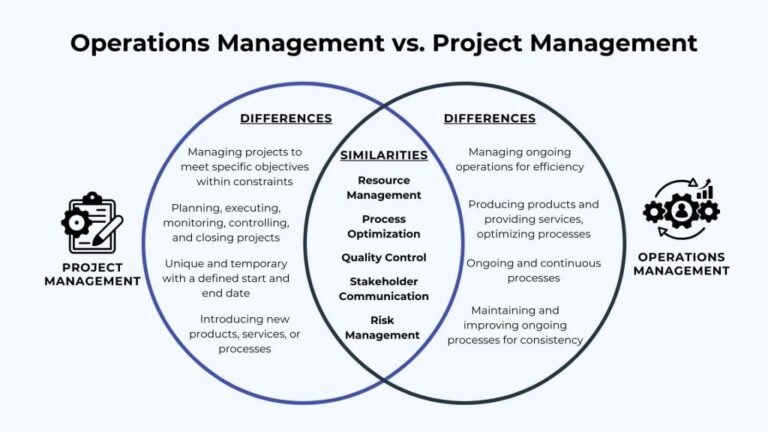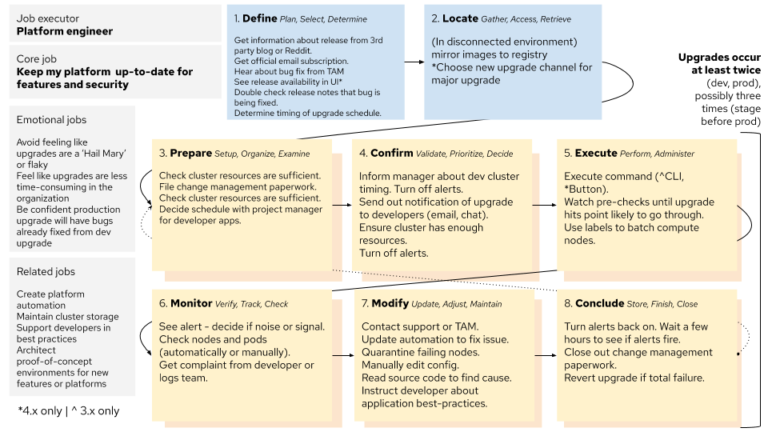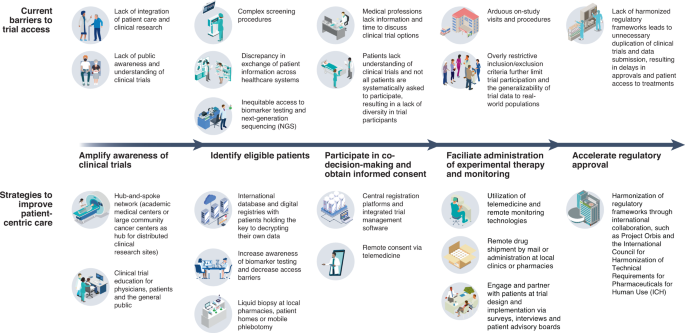What are the Key Elements of Successful Project Management: Essential Guide
Successful project management requires clear goals, effective communication, strong leadership, proper planning, risk management, task delegation, and continuous performance tracking for optimal results.
To excel in project management, certain elements are crucial. Managing a project can be overwhelming without a clear strategy. There are essential components that contribute to success. Clear goals, effective communication, and proper resource management are just a few. Understanding these key elements can help in navigating the complexities of any project.
This blog will dive into the critical aspects that make project management successful. Whether you are new to project management or looking to enhance your skills, knowing these elements will guide you toward achieving your project goals effectively. Let’s explore what makes project management successful and how you can apply these principles.
Project Planning
Project planning is a crucial phase in project management. It sets the foundation for the entire project. Effective planning ensures that all resources are used efficiently. It also helps in meeting deadlines and achieving goals.
Setting Objectives
Setting clear objectives is the first step in project planning. Objectives provide direction and focus. They help in measuring progress and success. Objectives should be specific, measurable, achievable, relevant, and time-bound (SMART).
- Specific: Clear and precise goals.
- Measurable: Quantifiable outcomes.
- Achievable: Realistic and attainable.
- Relevant: Aligned with broader goals.
- Time-bound: Defined deadlines.
Defining Scope
Defining the scope of the project is another key element. The scope outlines what is included and what is not. It helps in managing expectations and avoiding scope creep.
| Included | Excluded |
|---|---|
| Project deliverables | Out-of-scope tasks |
| Project milestones | Non-essential activities |
Clearly defining the scope ensures that everyone is on the same page. It helps in resource allocation and budgeting.
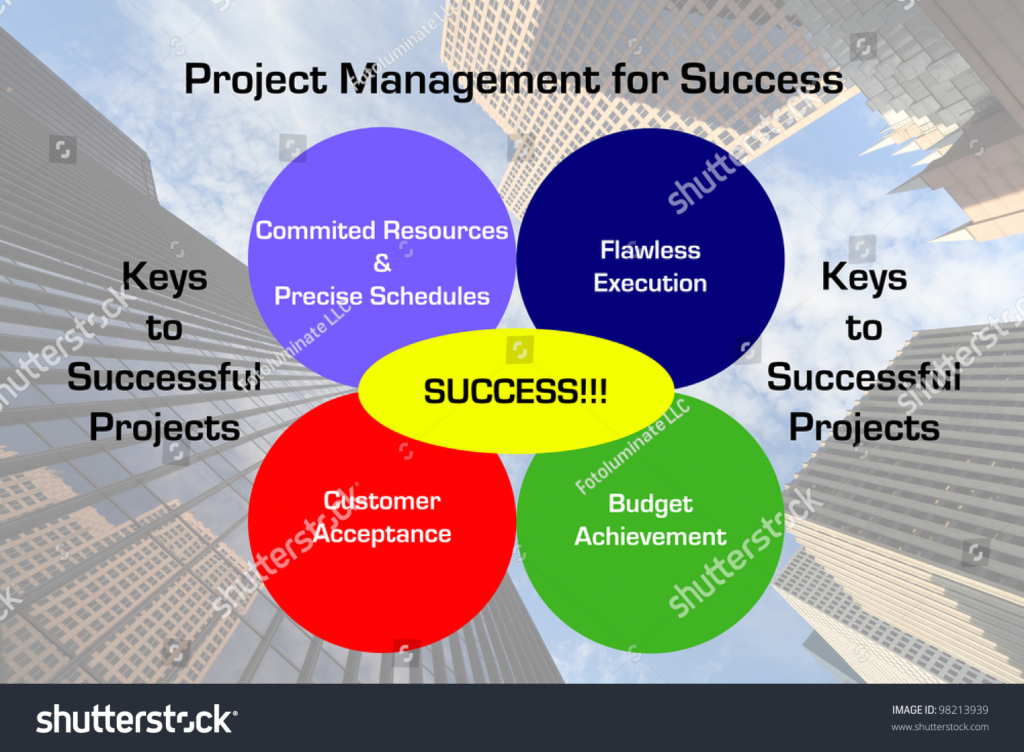
Credit: www.shutterstock.com
Team Management
Effective team management is crucial for successful project management. It ensures tasks are completed on time, within budget, and to the desired quality. Below, we explore key elements of team management.
Role Assignment
Assigning roles clearly is vital. Each team member should know their responsibilities. This avoids confusion and ensures accountability. Use a responsibility assignment matrix to map tasks to team members. This helps in tracking progress and identifying bottlenecks.
| Task | Responsible | Accountable | Consulted | Informed |
|---|---|---|---|---|
| Task 1 | Team Member A | Team Leader | Expert 1 | Stakeholder 1 |
| Task 2 | Team Member B | Team Leader | Expert 2 | Stakeholder 2 |
Effective Communication
Clear communication is the backbone of any project. Use various channels to ensure everyone is on the same page. Regular meetings, emails, and instant messaging help maintain clarity.
- Regular Meetings: Schedule weekly or bi-weekly meetings.
- Emails: Use for detailed information and updates.
- Instant Messaging: Quick queries and immediate responses.
Encourage open communication. Create an environment where team members feel comfortable sharing ideas and concerns. This fosters collaboration and innovation.
Resource Allocation
Resource allocation is the core of project management. Efficient use of resources ensures project success. This involves careful planning and distribution of human resources, materials, and capital. Let’s dive into the key elements: Budget Management and Time Management.
Budget Management
Effective budget management is crucial. It helps avoid overspending and resource depletion. Here are the key points to consider:
- Estimate Costs: Accurately predict costs for each task. Use historical data.
- Allocate Funds: Distribute funds based on task priority and cost estimates.
- Monitor Expenses: Track spending regularly. Adjust allocations as needed.
Consider this simple budget management table:
| Task | Estimated Cost | Actual Cost | Variance |
|---|---|---|---|
| Design | $5,000 | $4,800 | $200 |
| Development | $10,000 | $9,500 | $500 |
| Testing | $3,000 | $3,200 | -$200 |
Time Management
Time management ensures project tasks are completed on schedule. Here are the main steps:
- Create a Timeline: Break down the project into tasks. Assign deadlines.
- Prioritize Tasks: Identify critical tasks. Focus on these first.
- Track Progress: Use tools to monitor task completion. Adjust timelines if necessary.
Effective time management helps prevent delays. It keeps the project on track and within scope.
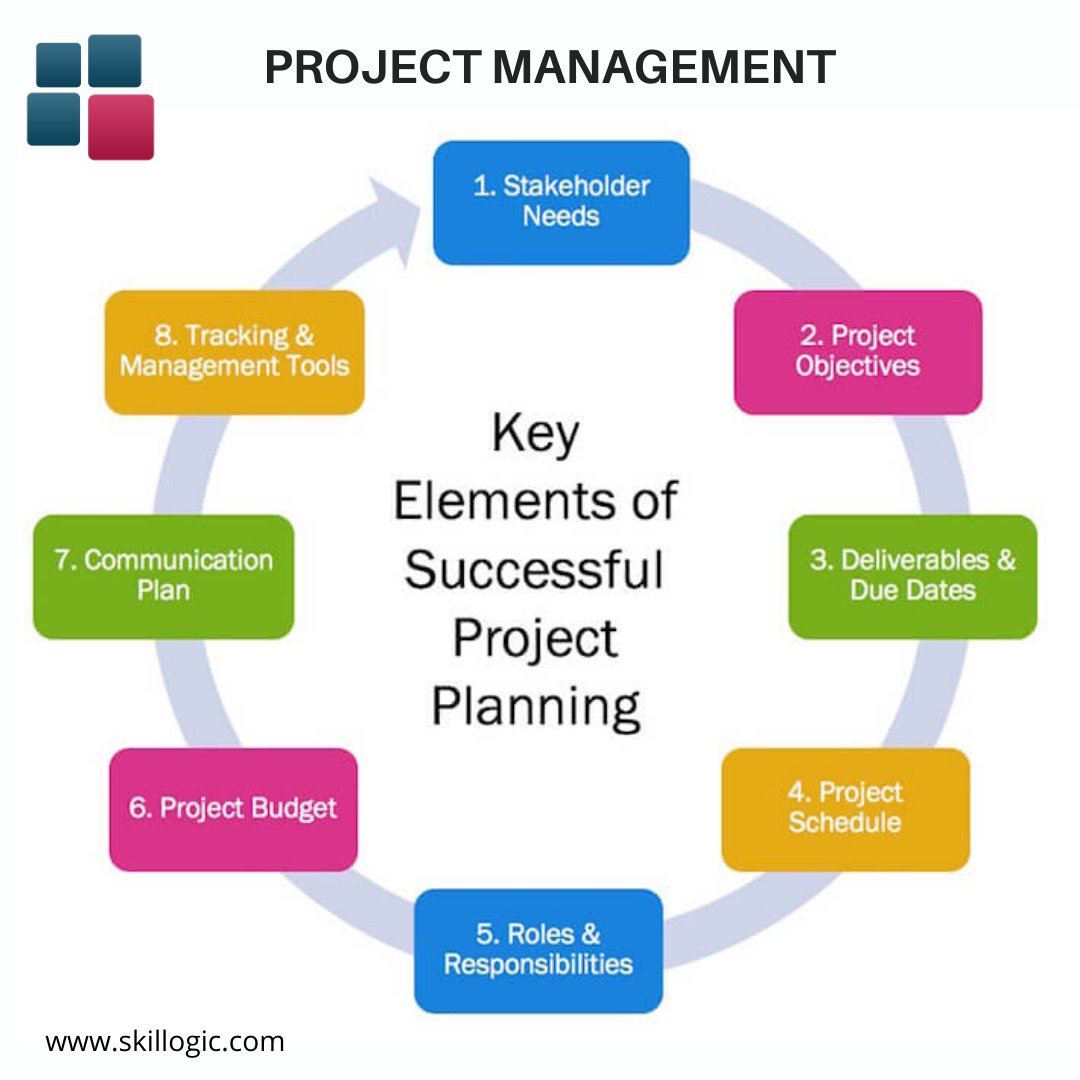
Credit: twitter.com
Risk Management
Risk management is a crucial element of successful project management. It involves identifying, assessing, and controlling potential threats to a project’s goals. Effective risk management can save time, money, and resources. This leads to a smoother project execution.
Identifying Risks
The first step in risk management is identifying risks. This involves recognizing potential problems that could affect the project. Use tools like SWOT analysis and brainstorming sessions. These help in pinpointing internal and external risks.
Here are some common types of risks:
- Technical risks
- Operational risks
- Financial risks
- External risks
Create a risk register to document identified risks. This register helps in tracking and managing risks throughout the project.
Mitigation Strategies
After identifying risks, the next step is to plan mitigation strategies. These strategies aim to reduce the impact or likelihood of risks.
Here are some common mitigation strategies:
- Avoidance: Change plans to eliminate the risk.
- Reduction: Take steps to reduce the impact or likelihood of the risk.
- Transfer: Shift the risk to a third party, such as through insurance.
- Acceptance: Acknowledge the risk and prepare a response plan.
Use a risk matrix to prioritize risks. This matrix helps in visualizing the probability and impact of each risk.
| Probability | Impact | Risk Level |
|---|---|---|
| High | High | Critical |
| High | Low | Moderate |
| Low | High | Significant |
| Low | Low | Minor |
Regularly review and update your risk management plan. This ensures that new risks are identified and managed effectively.
Quality Control
Quality control is essential for successful project management. It ensures that the project meets the required standards and satisfies stakeholders. Effective quality control involves monitoring activities, identifying defects, and ensuring that the final product is of high quality.
Setting Standards
Setting standards is the first step in quality control. It involves defining the criteria that the project must meet. These standards can be based on industry norms, client requirements, or internal benchmarks. Clear and well-defined standards help guide the project team and set expectations.
- Define quality benchmarks early in the project
- Ensure standards align with client expectations
- Document standards for easy reference
Having clear standards helps avoid misunderstandings and ensures everyone is on the same page. It creates a solid foundation for quality assurance activities.
Quality Assurance
Quality assurance focuses on maintaining quality throughout the project lifecycle. It involves regular checks, reviews, and audits to ensure the project adheres to the set standards. These activities help identify potential issues early and mitigate risks.
- Conduct regular quality audits
- Implement continuous improvement practices
- Engage stakeholders in quality reviews
Effective quality assurance requires a proactive approach. It involves continuous monitoring and adjustments to maintain high standards. Ensuring quality at every stage helps avoid costly rework and enhances customer satisfaction.
In summary, quality control in project management involves setting clear standards and conducting regular quality assurance activities. This ensures the final product meets the required standards and satisfies stakeholders.
Stakeholder Engagement
Effective stakeholder engagement is crucial in project management. It ensures all parties involved are on the same page. Proper engagement helps in achieving project goals efficiently. Let’s explore the key elements of stakeholder engagement.
Identifying Stakeholders
To engage stakeholders, first, you must identify them. They can be anyone impacted by the project. This includes team members, clients, sponsors, and even end-users. Make a comprehensive list. Understanding their roles and interests is vital.
- Team members
- Clients
- Sponsors
- End-users
Use a stakeholder matrix to categorize them. This helps in prioritizing their needs and expectations. Here’s a simple example of a stakeholder matrix:
| Stakeholder | Interest | Impact |
|---|---|---|
| Team Member | High | High |
| Client | Medium | High |
| Sponsor | Low | Medium |
| End-User | High | Low |
Managing Expectations
Managing stakeholder expectations is key to project success. Clear communication is essential. Use regular updates to keep everyone informed. Create a communication plan that outlines:
- Frequency of updates
- Channels of communication
- Types of information shared
Set realistic goals and timelines. Be transparent about potential risks and challenges. Use feedback loops to understand stakeholder concerns. Address them promptly to maintain trust.
Remember, engaged stakeholders are more likely to support your project. They provide valuable insights and resources. Effective engagement leads to smoother project execution and better outcomes.
Monitoring And Evaluation
Monitoring and Evaluation are crucial for successful project management. These processes help ensure that the project stays on track and achieves its goals. They involve regular checks and assessments to measure progress and performance.
Tracking Progress
Tracking progress helps in identifying whether the project is on schedule. It involves regular updates and reviews. This ensures that tasks are completed on time. A simple way to track progress is through project management tools. These tools provide real-time updates and status reports.
Another method is to use a Gantt chart. This visual tool shows the timeline of the project. It helps in understanding which tasks are on track and which are delayed. Regular meetings are also essential. These can be daily or weekly check-ins to discuss progress and issues.
Performance Metrics
Performance metrics are standards used to measure the efficiency of the project. They help in understanding how well the project is doing. Common metrics include:
- Completion rate: This shows the percentage of tasks completed.
- Budget variance: This measures the difference between the planned and actual budget.
- Time variance: This shows the deviation from the planned schedule.
- Quality metrics: These assess the quality of the deliverables.
Using these metrics helps in making informed decisions. They provide a clear picture of the project’s health. If any metric shows a negative trend, corrective actions can be taken.
Consider using a dashboard to display these metrics. Dashboards provide a visual representation of data. They make it easy to understand complex information quickly. Regular evaluation of these metrics ensures that the project remains aligned with its objectives.
Project Closure
Project closure is a vital phase in project management. It ensures that all project activities are completed and goals are met. This phase is about finalizing everything and ensuring no loose ends. It involves handing over deliverables, analyzing performance, and documenting lessons learned.
Final Deliverables
The final deliverables are the output of the project. They are what the stakeholders have been waiting for. These deliverables should meet the agreed-upon criteria. It is crucial to ensure they are complete, functional, and meet quality standards.
Here is a table to summarize the key aspects of the final deliverables:
| Aspect | Description |
|---|---|
| Completeness | All components are included. |
| Functionality | Deliverables work as intended. |
| Quality | Meets the required standards. |
Ensure stakeholders sign off on the deliverables. This formalizes the acceptance and closure of the project.
Post-project Review
The post-project review is an essential step. It helps the team reflect on the project. This review focuses on what went well and what could be improved.
Key elements of a post-project review include:
- Performance Analysis
- Lessons Learned
- Team Feedback
Conducting a post-project review involves the following steps:
- Gather data and feedback.
- Analyze the project’s performance.
- Document lessons learned.
- Share findings with stakeholders.
Documenting the lessons learned is crucial. It provides valuable insights for future projects. This helps in avoiding past mistakes and improving future performance.
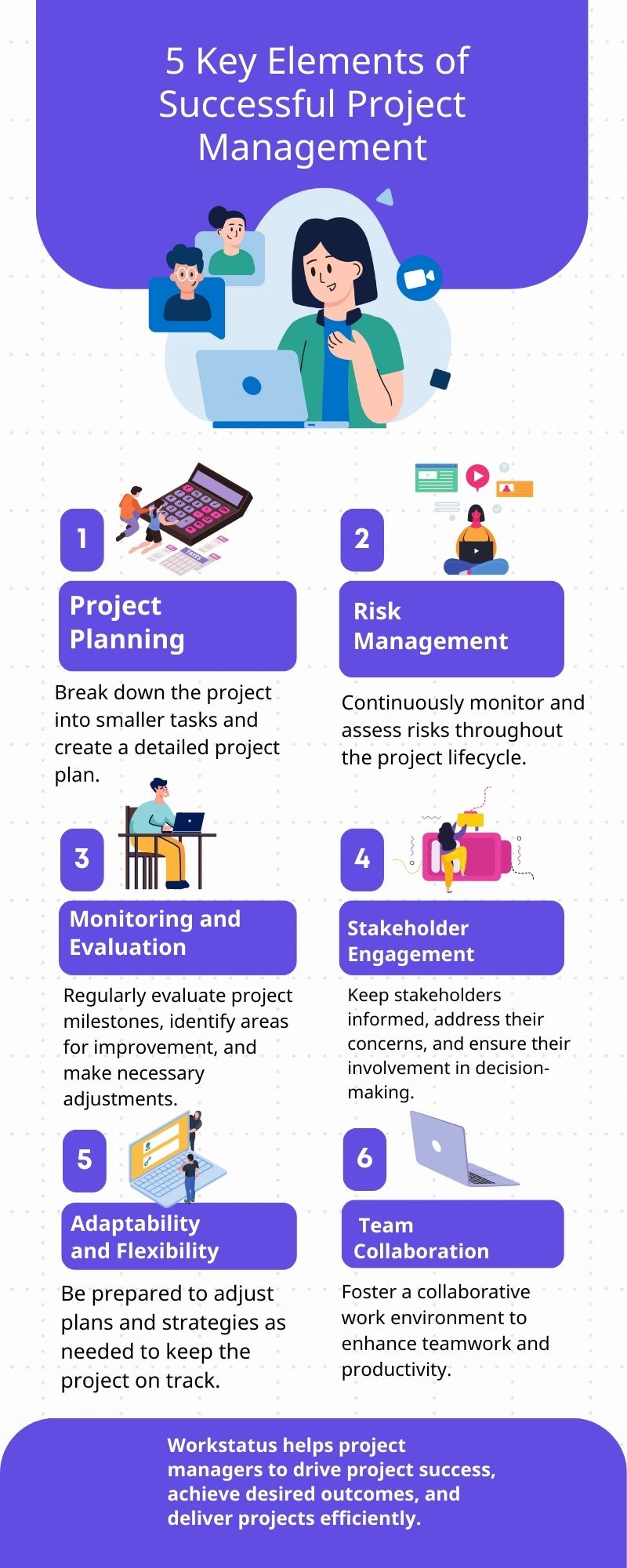
Credit: www.workstatus.io
Frequently Asked Questions
What Are The Key Elements In Project Management?
Key elements in project management include defining goals, creating a plan, allocating resources, and monitoring progress. Effective communication and risk management are also crucial.
How Does Communication Impact Project Success?
Effective communication ensures all team members are aligned with project goals. It helps in resolving issues quickly and maintaining project momentum.
Why Is Risk Management Important In Projects?
Risk management helps identify potential problems early. This allows teams to mitigate risks before they impact the project’s success.
What Role Does Resource Allocation Play In Project Management?
Proper resource allocation ensures that the right people and materials are available when needed. This maximizes efficiency and project success.
Conclusion
Successful project management relies on several key elements. Clear goals guide the team. Strong communication keeps everyone aligned. Effective leadership inspires and motivates. Proper planning ensures smooth execution. Risk management prevents setbacks. Monitoring progress helps stay on track. Lastly, flexibility allows for adjustments.
Embrace these elements for better project outcomes. Your projects will run smoother. Your team will work more efficiently. Success becomes achievable with these strategies. Remember, good project management is about balance and adaptability. Keep learning and refining your approach. Your future projects will thank you.



